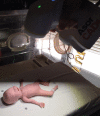Development of a 3D Individualized Mask for Neonatal Non-Invasive Ventilation
- PMID: 35669323
- PMCID: PMC9159482
- DOI: 10.18063/ijb.v8i2.516
Development of a 3D Individualized Mask for Neonatal Non-Invasive Ventilation
Abstract
Non-invasive masks are designed based on generic facial models; therefore, difficulties in fitting patients' unique characteristics are common. A poor fit of the mask may have consequences such as air leaks or pressure ulcers. It is possible to optimize the fit of interfaces by adapting them to a patient's face. Our objective is to design an individualized silicone mask for non-invasive ventilation for a premature phantom using a three-dimensional (3D) scanner and bioprinter. The facial surface of the manikin was scanned with a 3D scanner in a supine position, in an incubator with a sliding mattress and in <2 min. We printed the tailor-made mask in 3 h with biocompatible and hypoallergenic silicone. When applied under a simulated clinical scenario, the mask possessed good structural reliability after post-processing and optimal mechanical features. We observed adequate thoracic excursion and 14% reduction in air leaks when the manikin was ventilated with the customized mask with a neonatal ventilator. We ink the edges of personalized and standard masks. After fitting them to phantoms, personalized mask showed better pressure distribution. Our subsequent research direction is to test the viability of personalizing non-invasive ventilation masks for very preterm infants of our department.
Keywords: 3D printing; Mask; Non-invasive ventilation; Premature infant; Pressure ulcer.
Copyright: © 2022 Borràs-Novell, et al.
Conflict of interest statement
Authors Cristina Borràs-Novell, Mario García Causapié and Oscar García-Algar do not have conflicts of interest. Authors Maria Murcia and Damien Djian work in Elkem Company as Sales Manager HC&IAM Iberia and Sales Expert 3D printing Europa and R&I – Compentence Center – ATRiON respectively. The mentioned companies had altruist collaboration in the current project, within the framework of Research & Development.
Figures




References
-
- Aufieri R, Picone S, Gente M, et al. 3D Printing in Neonatal Care. Ital J Pediatr. 2015;41:A1. http://doi.org/10.1186/1824-7288-41-s1-a1.
-
- Morrison RJ, VanKoevering KK, Nasser HB, et al. Conference:Combined Otolaryngology Spring Meetings. Boston: 2015. Personalized 3D-Printed CPAP Masks Improve CPAP Effectiveness in Children with OSA and Craniofacial Anomalies Robert'. http://doi.org/10.13140/RG.2.1.2328.1687.
-
- Hsu DY, Cheng YL, Bien MY, et al. Development of a Method for Manufacturing Customized Nasal Mask Cushion for CPAP Therapy. Australas Phys Eng Sci Med. 2015;38:657–66. http://doi.org/10.1007/s13246-015-0383-0. - PubMed
-
- Sela M, Toledo N, Honen Y, et al. Customized Facial Constant Positive Air Pressure (CPAP) Masks. 2016. [Last accessed on 2021 Sep 23]. Available from: http://arxiv.org/abs/1609.07049 .
LinkOut - more resources
Full Text Sources
